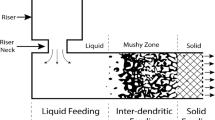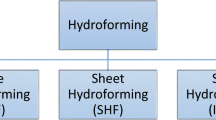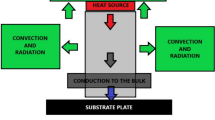Abstract
The manufacturing technique known as investment casting has found extensive application in producing metal components featuring intricate geometries. The production efficiency of the wax patterns is an essential issue in the investment casting industry, especially for the mass production of wax patterns. A conformal cooling channel (CCC) performs the rapid uniform cooling process for injection molding. However, the significant pressure drop along the cooling channels is a distinct disadvantage of CCC. In this study, an innovative waterfall cooling channel (WCC) was proposed and implemented. The WCC cools the injected products by surface contact, replacing the conventional line contact to cool the injected products. The WCC was optimized using Moldex3D simulation software. Rapid tools with two kinds of cooling channels were designed and implemented. The cooling time of the molded part was investigated using a low-pressure wax injection molding machine. Considering a water cup characterized by a mouth diameter of 70 mm, a height of 60 mm, and a thickness of 2 mm, the experimental results confirmed that the use of WCC can save the cooling time of the product by about 265 s compared with the CCC. This result shows that the WCC can increase cooling efficiency by approximately 17.47% compared with conventional CCC.













Similar content being viewed by others
Availability of data and material
Data and materials are available.
Code availability
Not applicable.
References
Wang J, Xuan J, Ni Y (2023) Automatic design of conformal cooling channels of injection mold based on lotus root model. Int J Adv Manuf Technol 125:1879–1892
Wang BW, Nian SC, Huang MS (2022) Strategies for adjusting process parameters in CAE simulation to meet real injection molding condition of screw positions and cavity pressure curves. Int J Adv Manuf Technol 122:1339–1351
Arman S, Lazoglu I (2023) A comprehensive review of injection mold cooling by using conformal cooling channels and thermally enhanced molds. Int J Adv Manuf Technol 127:2035–2106
Kuo CC, You ZY (2022) A simple method for enhancing the flexural strength of epoxy-based rapid soft tooling with conformal cooling channels. Int J Adv Manuf Technol 121:1887–1897
Kuo C-C, Chen W-H (2021) Improving cooling performance of injection molding tool with conformal cooling channel by adding hybrid fillers. Polymers 13:1224
Kwak JB (2019) Completely in situ and non-contact warpage assessment using 3D DIC with virtual patterning method”. Int J Adv Manuf Technol 100(9–12):2803–2811
Mercado-Colmenero JM, Martin-Doñate C, Rodriguez-Santiago M, Moral-Pulido F, Rubio-Paramio MA (2019) A new conformal cooling lattice design procedure for injection molding applications based on expert algorithms. Int J Adv Manuf Technol 102(5–8):1719–1746
Abbès B, Abbès F, Abdessalam H, Upganlawar A (2019) Finite element cooling simulations of conformal cooling hybrid injection molding tools manufactured by selective laser melting. Int J Adv Manuf Technol 103(5–8):2515–2522
Singraur DS, Patil BT, Rampariya Y (2019) Advancements in design and fabrication of conformal cooling channels for improvement in plastic injection molding process”. Ind Eng J 12(5):1–6
Mercado-Colmenero JM, Rubio-Paramio MA, Marquez-Sevillano JDJ, Martin-Doñate C (2018) A new method for the automated design of cooling systems in injection molds. Comput Aided Des 104:60–86
Nguyen V-T, Minh PS, Uyen TMT, Do TT, Ha NC, Nguyen VTT (2023) Conformal cooling channel design for improving temperature distribution on the cavity surface in the injection molding process. Polymers 15:2793
Minh PS, Dang H-S, Ha NC (2023) Optimization of 3D cooling channels in plastic injection molds by taguchi-integrated principal component analysis (PCA). Polymers 15:1080
Choi JH, Gim J, Rhee B (2023) A novel design method of an evolutionary mold cooling channel using biomimetic engineering. Polymers 15:798
Torres-Alba A, Mercado-Colmenero JM, Caballero-Garcia JDD, Martin-Doñate C (2023) Application of new conformal cooling layouts to the green injection molding of complex slender polymeric parts with high dimensional specifications. Polymers 15:558
Gotlih J, Brezocnik M, Pal S, Drstvensek I, Karner T, Brajlih T (2022) A holistic approach to cooling system selection and injection molding process optimization based on non-dominated sorting. Polymers 14:4842
Kanbur BB, Zhou Y, Shen S, Wong KH, Chen C, Shocket A, Duan F (2022) Metal Additive manufacturing of plastic injection molds with conformal cooling channels. Polymers 14:424
Torres-Alba A, Mercado-Colmenero JM, Caballero-Garcia JDD, Martin-Doñate C (2021) A hybrid cooling model based on the use of newly designed fluted conformal cooling channels and fastcool inserts for green molds. Polymers 13:3115
Piekło J, Garbacz-Klempka A (2023) Analysis of phenomenon of plasticity loss of steel core made by selective laser melting method in zone of pressure mould conformal cooling channel. Materials 16:4205
MohdHanid MH, Abd Rahim SZ, Gondro J, Sharif S, Al Bakri Abdullah MM, Zain AM, El-HadjAbdellah A, Mat Saad MN, Wysłocki JJ, Nabiałek M (2021) Warpage optimisation on the moulded part with straight drilled and conformal cooling channels using response surface methodology (RSM), glowworm swarm optimisation (GSO) and genetic algorithm (ga) optimisation approaches. Materials 14:1326
Piekło J, Garbacz-Klempka A (2020) Use of maraging steel 1.2709 for implementing parts of pressure mold devices with conformal cooling system. Materials 13:5533
Torres-Alba A, Mercado-Colmenero JM, Diaz-Perete D, Martin-Doñate C (2020) A new conformal cooling design procedure for injection molding based on temperature clusters and multidimensional discrete models. Polymers 12:154
Kuo CC, Xu YX (2022) A simple method of improving warpage and cooling time of injection molded parts simultaneously. Int J Adv Manuf Technol 122:619–637
Kuo CC, Peng JG, Hong PC et al (2023) Optimization of removal process parameters of polyvinyl butyral cooling channel in rapid silicone rubber molds using the Taguchi method. Int J Adv Manuf Technol 128:2365–2376
Smirnov A, Terekhina S, Tarasova T et al (2023) From the development of low-cost filament to 3D printing ceramic parts obtained by fused filament fabrication. Int J Adv Manuf Technol 128:511–529
Hussam H, Abdelrhman Y, Soliman MES et al (2022) Effects of a new filling technique on the mechanical properties of ABS specimens manufactured by fused deposition modeling. Int J Adv Manuf Technol 121:1639–1650
Kuo CC, You ZY, Chang SJ et al (2020) Development of green conformal cooling channels for rapid tooling. Int J Adv Manuf Technol 111:109–125
Müller M, Jirků P, Šleger V, Mishra RK, Hromasová M, Novotný J (2022) Effect of infill density in FDM 3D printing on low-cycle stress of bamboo-filled PLA-based material. Polymers 14:4930
Guiza G, Larcher A, Goetz A, Billon L, Meliga P, Hachem E (2020) Anisotropic boundary layer mesh generation for reliable 3D unsteady RANS simulations”. Finite Elem Anal Des 170:103345–103351
Rao NS, Schumacher G, Schott NR, O’Brien KT (2002) Optimization of cooling systems in injection molds by an easily applicable analytical model. J Reinf Plast Comp 21:451–459
Pereira M, Zirak N, Shirinbayan M et al (2023) Design, fabrication, and evaluation of a small turbine blade manufactured by rotational molding. Int J Adv Manuf Technol 128:3441–3450
Li F, Wang D, Jiang Y et al (2019) Effect of centrifugal casting process on mold filling and grain structure of K418B turbine guide. Int J Adv Manuf Technol 104:3065–3072
Kurusu RS, Gholami M, Demarquette NR et al (2023) Surface properties of molds for powder injection molding and their effect on feedstock moldability and mold adhesion. Int J Adv Manuf Technol 126:381–390
Guerra NB, Reis TM, Scopel T et al (2023) Influence of process parameters and post-molding condition on shrinkage and warpage of injection-molded plastic parts with complex geometry. Int J Adv Manuf Technol 128:479–490
Guo W, Shen W, Zeng F et al (2023) Investigation of film–substrate interfacial characteristics of polymer parts fabricated via in-mold decoration and microcellular injection molding process. Int J Adv Manuf Technol 125:4363–4377
Gel’atko M, Hatala M, Botko F, Vandžura R, Hajnyš J, Šajgalík M, Török J (2023) Stress relieving heat treatment of 316Lstainless steel made by additive manufacturing process. Materials 16:6461
Kuo C-C, Tasi Q-Z, Huang S-H, Tseng S-F (2023) Enhancing surface temperature uniformity in a liquid silicone rubber injection mold with conformal heating channels. Materials 16:5739
Kuo C-C, Qiu S-X (2021) A simple method of reducing coolant leakage for direct metal printed injection mold with conformal cooling channels using general process parameters and heat treatment. Materials 14:7258
Kuo C-C, Pan X-Y (2023) Development of a rapid tool for metal injection molding using aluminum-filled epoxy resins. Polymers 15:3513
Kuo C-C, Tasi Q-Z, Hunag S-H, Tseng S-F (2023) Development of an injection mold with high energy efficiency of vulcanization for liquid silicone rubber injection molding of the fisheye optical lens. Polymers 15:2869
Torvi SP, Nepal B, Wang J (2023) Energy mapping of additive manufacturing processes using sankey diagrams. Int J Adv Manuf Technol 128:4551–4560
Riegger F, Wenzler DL, Zaeh MF (2024) Stud and wire arc additive manufacturing—development of a combined process for the high-productivity additive manufacturing of large-scale lattice structures. J Adv Join Process 9:100189
Amiri V, Naffakh-Moosavy H (2024) Wire arc additive manufacturing of functionally graded carbon steel - stainless steel 316L - Inconel 625: microstructural characterization and mechanical behavior. J Adv Join Process 9:100194
Grothe R, Pohl M, Troschitz J, Weidermann Ch, Weiss K-P, Gude M (2024) Characterization of intrinsic interfaces between fibre-reinforced composites and additively manufactured metal for designing hybrid structures. J Adv Join Process 9:100209
Funding
This study received financial support from the Ministry of Science and Technology of Taiwan under contract nos. NSTC 111–2221-E-131–015-MY2, MOST 110–2221-E-131–023, and MOST 109–2637-E-131–004.
Author information
Authors and Affiliations
Contributions
Chil-Chyuan Kuo wrote the paper, conceived and designed the analysis, and performed the analysis. Pin-Han Lin, Jing-Yan Xu, Zhe-Xhi Lin, Zi-Huan Wang, Zhi-Jun Lai, and Song-Hua Huang collected the data and contributed data or analysis tools.
Corresponding author
Ethics declarations
Ethics approval
Not applicable.
Consent to participate
We are agreeing to participate.
Consent for publication
We are agreeing to publish this work.
Conflict of interest
The authors declare no competing interests.
Additional information
Publisher's Note
Springer Nature remains neutral with regard to jurisdictional claims in published maps and institutional affiliations.
Rights and permissions
Springer Nature or its licensor (e.g. a society or other partner) holds exclusive rights to this article under a publishing agreement with the author(s) or other rightsholder(s); author self-archiving of the accepted manuscript version of this article is solely governed by the terms of such publishing agreement and applicable law.
About this article
Cite this article
Kuo, CC., Lin, PH., Xu, JY. et al. Cooling efficiency enhancement using a rapid tool with a surface-cooled waterfall cooling channel. Int J Adv Manuf Technol 132, 1127–1136 (2024). https://doi.org/10.1007/s00170-024-13429-7
Received:
Accepted:
Published:
Issue Date:
DOI: https://doi.org/10.1007/s00170-024-13429-7




